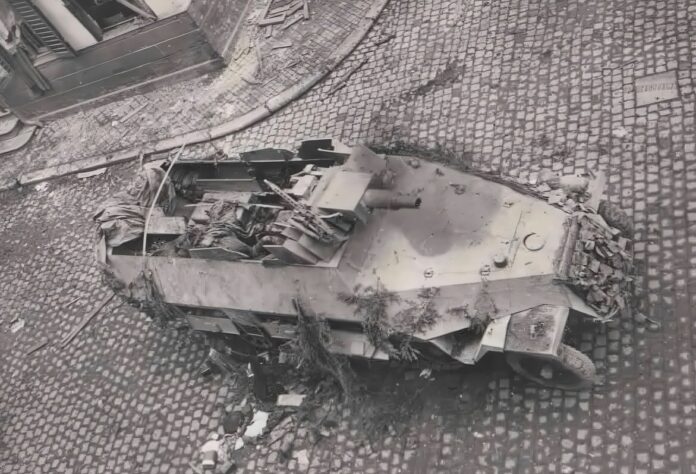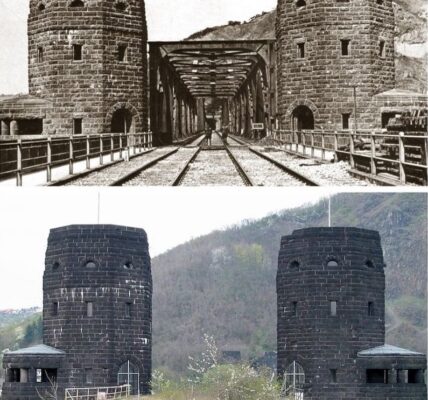
Description
The m.Schütz.Pz.Wg. (Sd.Kfz.251/9) , nicknamed the “Stummel,” was an infantry support vehicle developed by Nazi Germany in 1942 during World War II. The Wehrmacht had learned from its experience on the Eastern Front and, having a surplus of 7.5 cm howitzers due to the Panzer IV and StuG III being upgraded with more powerful anti-tank weapons, decided to use the already proven Sd.Kfz.251 platform to mount this gun and use it as an infantry support weapon. Initially armed only with the cannon and a short firing range, the vehicle proved unsatisfactory, but after being upgraded with a new carriage and a coaxial machine gun, it saw widespread use on the Eastern Front. It served primarily in armored reconnaissance units and was used in areas where tanks could not support infantry due to uneven terrain or weak infrastructure (such as roads or bridges), which posed no problem for the Sd.Kfz. 251/9. As a direct-fire platform, it proved to be very good, reliable, inexpensive to produce and maintain, and filled the need for a “bunker buster” vehicle on the Eastern Front.
Introduced with the Fire and Ice update, the “Stub” is considered a capable vehicle against its opponents. While its armor isn’t good enough to stop even 12.7mm shells, its cannon and mobility make up for this lack of protection. The HEAT shells are best suited to dealing with most enemies, and can be used effectively against armored and open-sided vehicles. The 870g of explosive mass ensures that most enemies are eliminated, but the damage after a penetration can feel insufficient. The APCBC can be used specifically in flanking maneuvers, but has lower penetration and speed than the HEAT shells, making it even more difficult to hit enemies. Mobility is sufficient, allowing you to rush to capture points and then hide in advantageous positions to ambush passing tanks.
Use in battles
The Sd.Kfz. 251/9 is a lightly armored vehicle that can be penetrated by almost anything, including heavy machine guns, and can be destroyed by overpressure. This means you should avoid attack points and heavily trafficked areas and instead flank the enemy team with your good mobility. The 251/9’s 75mm gun is excellent for its combat value and features an APCBC shell with moderate penetration, as well as an excellent HEAT shell with a good explosive charge and 100mm penetration from all angles. However, sniper fire with this tank is not recommended, as its gun and shells have a low muzzle velocity and high drop, making it difficult to hit targets at range. This tank is better suited for ambush. If you find a good position that protects your sides and flanks from enemy tanks, you can surprise and quickly destroy almost any enemy tank that comes your way with your excellent reload speed and HEAT shells. It also has excellent depression angle, allowing you to attack enemy targets over hills and giving you greater flexibility in combat.
The biggest threats to this tank are aircraft and flanking attacks. Being an open-topped vehicle, it is vulnerable to attacks and bombing from enemy aircraft. Lacking a turret, the 251/9 also struggles with flanking maneuvers and will be lost if an enemy tanker flanks and gets a good shot profile to the side of your tank. To counteract this, stay with your teammates and/or switch positions after firing a few shots to prevent players whose tanks you’ve destroyed from coming back and bombing you with revenge. It can also be beneficial to work with friendly anti-aircraft defenses, as they can provide some protection against CAS.
pros and cons
Advantages:
- Very mobile for the BR, gets to the destination quickly.
- Powerful weapon with fast reloading that enables versatile enemy encounters
- Gun depression allows hull-down positions
- Smoke grenades available, useful for covering friendly movements, especially good thanks to the short reload time
Disadvantages:
- Open roof, vulnerable to HE grenades, artillery attacks and low-level attacks
- A single shot can disable the driver, gunner, and loader simultaneously, leaving you vulnerable.
- Weak mobility in difficult terrain compared to tanks due to the construction without full tracks
- Relatively low projectile velocity for the main gun
Story

Medium infantry fighting vehicle (Sd.Kfz 251/9) Ausf. D “Stummel”
The m.Schütz.Pz.Wg. (Sd.Kfz.251/9) was developed based on the Sd. Kfz. 251 platform, which had already proven itself as an infantry fighting vehicle and in other roles. This variant was developed specifically for infantry support, based on experience on the Eastern Front and the need for a more cost-effective assault gun against Soviet fortifications and entrenched infantry.
The choice fell on the 7.5 cm K. 37 L/24, which was available in large numbers after the Panzer IV and StuG III had been retrofitted with more powerful anti-tank guns. Early versions of this gun proved unsatisfactory, with a horizontal traverse of 10 to 12 degrees and only -5 degrees of gun depression. Nevertheless, the vehicle was sent to the Eastern Front, and an initial batch of 150 units was ordered.
The improved version entered service in 1944 with a revised 7.5 cm howitzer, a new carriage, a coaxial MG 42 machine gun, and a simpler design. This allowed for better maintenance and increased ammunition capacity thanks to the larger interior (many cartridges were carried in pouches and gun racks). The new design proved significantly more efficient; the horizontal traverse was increased to 20 degrees and the gun depression angle was reduced from -5 to -10 degrees.
The Stummel medium armored personnel carrier entered service with the 4th SS Panzer Regiment “Der Führer,” 2nd SS Panzer Division, on the Eastern Front in 1942. Most units served in this theater of operations and not against the Allied forces. Later in the war, the vehicle was used in all armored reconnaissance units for heavy fire support, as well as in the Hermann Göring Paratrooper Division, as the Stummel could be transported in the Me 323.
The vehicle offered the Wehrmacht a wide range of applications. For example, it was significantly cheaper to produce and maintain than the Panzer IV or the Stug III. When these tanks were converted from infantry support to anti-tank defense, it was significantly cheaper and easier to convert an existing platform like the Sd.Kfz. 250 for this new role. Furthermore, the so-called “Kanonenwagen” (cannon car) was lighter and could cross weak bridges alongside infantry and armored personnel carriers, providing direct fire support, and even assisting in anti-tank defense from advantageous positions.





